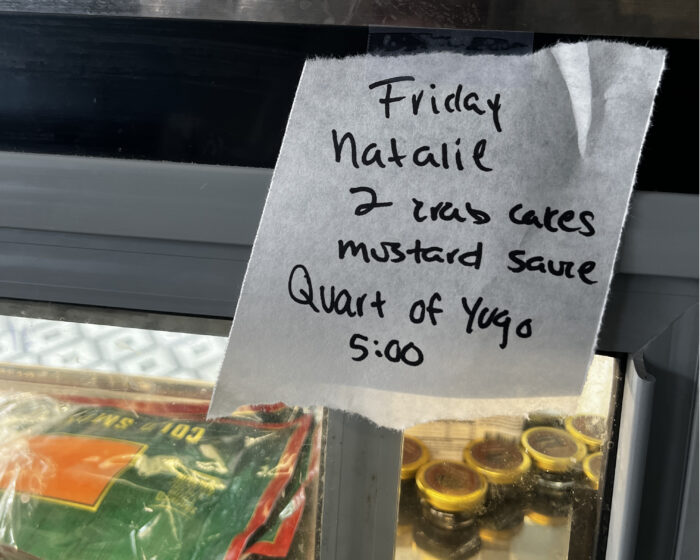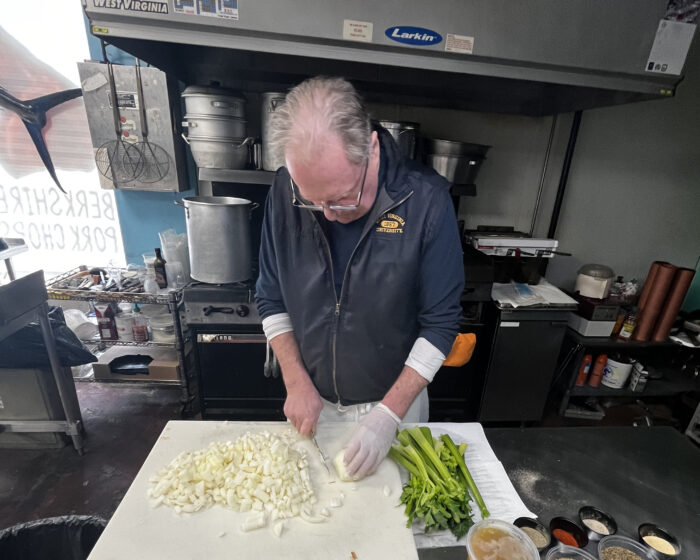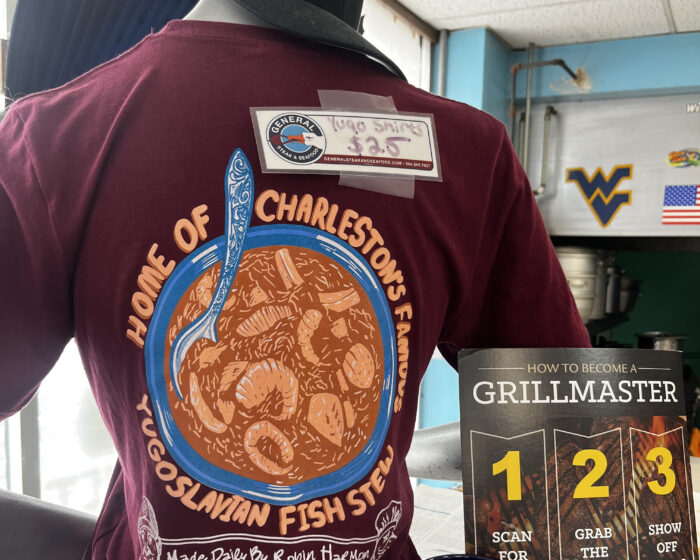Charleston's Hottest Lunch Is A Spicy Eastern European Stew - West Virginia Public Broadcasting (original) (raw)
This story originally aired in the March 19, 2023 episode of Inside Appalachia.
It’s lunchtime on the first Friday of Lent, that season when many Christians abstain from mammal meat, and it’s getting busy at General Steak and Seafood in downtown Charleston, West Virginia. Folks are stopping to buy shrimp, salmon and cod. But nothing is selling faster than the Yugoslavian stew — “Yugo stew,” if you’re a regular.
The shop started at 10 a.m. with about seven gallons on hand. There’s only a few quarts left.
“It’s very good,” longtime fan Philip Michael said. “It’s spicy. It’s got every kind of seafood, scallops and shrimp. It’s just very tasty and very filling, actually.”
The shop started getting calls as soon as it opened from regulars like Michael hoping to reserve a few containers.
“Sometimes they might be having company and want three quarts or four quarts or more,” General Steak and Seafood co-founder Robin Harmon said. “Some people buy five or six pints, take them to the office and give everybody one. It sells out every day.”

Regulars often phone ahead to reserve containers of Yugoslavian stew. Credit: Zack Harold/West Virginia Public Broadcasting
It’s been this way for over 40 years, before this current market existed. Back then, Robin and his brother Joe owned a combined restaurant and market a few streets over, as well as a bustling catering business.
Even then, the Harmon brothers were known for having the freshest seafood in town. But they had a problem. In those days, scallops didn’t come neatly wrapped and packed on refrigerated trucks. They arrived at Yeager Airport every day in 40 pound sacks. That led to a lot of broken pieces — perfectly edible, but not pretty enough to sell to customers.
The operation was also peeling 100 pounds of shrimp each day, between all of the businesses. Some of them inevitably looked a little worse for wear.
“Then everybody wants six- and eight-ounce center-cut pieces of fish, so we have all kinds of end pieces and trimmings,” Robin said.
The brothers had all perfectly good stuff, too delicious and expensive to throw away. They just didn’t have anything to do with it. Then one day, they found the solution in a copy of the newly launched “Cook’s Illustrated” magazine. It was a recipe for Dalmatian stew from the coastal region of Croatia — then part of Yugoslavia — where a lot of the local diet comes from the ocean.
“So it was actually a catch-all stew to use a lot of local marine life,” Robin said. “I modified it for restaurant use, because I wanted everything to be bite-sized and nothing in the shell, so you didn’t have to take things out of the shell, peel shrimp, and all that kind of stuff.”
Robin made other changes, too. He added extra spices and alot of hot sauce. Perhaps most importantly, he changed the name.
“When you spelled it out, it looked like ‘Dalmatian.’ So I didn’t want the dog thing with it,” he said.
But Dalmatian stew, by any other name, tastes just as delicious.
Though the fish is always fresh, Robin usually makes the soup base a day or two ahead. He starts by speed-chopping five onions. He throws them into a pot with warm, shimmering olive oil alongside several chopped stalks of celery and two whole heads of garlic, finely minced. Then come the spices: parsley, oregano, basil and three kinds of pepper — black, white and red.

Robin Harmon chops onions to create his Yugoslavian stew base. Credit: Zack Harold/West Virginia Public Broadcasting
He adds chicken stock and lets the mixture bubble away, allowing the flavors to condense. After that, he adds several gigantic cans of diced tomatoes and tomato sauce, granulated garlic, sugar and three kinds of hot sauce — Tabasco, Frank’s Red Hot, and Sriracha. Sriracha was a pretty exotic ingredient back when Robin first started making this stew in the early 1980s. His shop was probably the first place in Charleston to sell it.
“We bought it out of Cleveland,” he said. “Before you could buy it at a grocery store or anything, we sold it out of Broad Street.”
The soup base is finished once the hot sauce goes in. Tomorrow morning, Robin will heat it up and add the fish. This is the only part of the recipe that changes from day to day. It depends on what comes across the shop’s cutting boards — whether that’s salmon, swordfish, mahi mahi or catfish.
“There’s always calamari and shrimp and scallops in there, too,” Robin said.
Most of the fish goes in about 10 minutes before the soup is ready to serve. It doesn’t take long to cook. The shrimp takes even less time, going in the pot for just a couple minutes.
That’s great, because by this point, people are usually lining up for their Yugo stew.

Yugo stew is so popular, General Steak and Seafood put it on a t-shirt. Credit: Zack Harold/West Virginia Public Broadcasting
Densie Workman, a substitute teacher at a nearby elementary school, hopped over on her lunch break.
“It’s spicy and delicious, filled with seafood,” she said. “I have the recipe that was in the paper a few years ago. But I’ve never tried to make it. You can’t top this.”
Kim Brown, who entered the store just minutes after Workman, wasn’t so lucky. All the Yugo stew was gone.
“Darn it. I knew I was probably too late,” she said.
It seems like everyone in town has a hankering for this dish — everyone, except for one person.
“My brother still eats it. The other people who work here still eat it. But they don’t make it every day like I do,” Robin said. “It’s the first thing I do every day when I get here, put it on the stove. I haven’t eaten it in years.”
Well, that’s just more for the rest of us.
——
This story is part of the Inside Appalachia Folkways Reporting Project, a partnership with West Virginia Public Broadcasting’s Inside Appalachia and the Folklife Program of the West Virginia Humanities Council.
The Folkways Reporting Project is made possible in part with support from Margaret A. Cargill Philanthropies to the West Virginia Public Broadcasting Foundation. Subscribe to the podcast to hear more stories of Appalachian folklife, arts and culture.